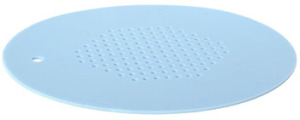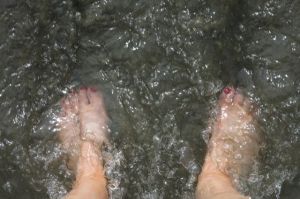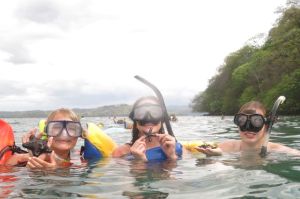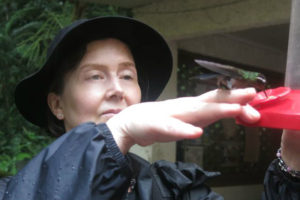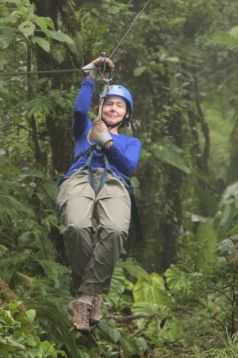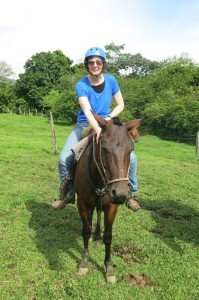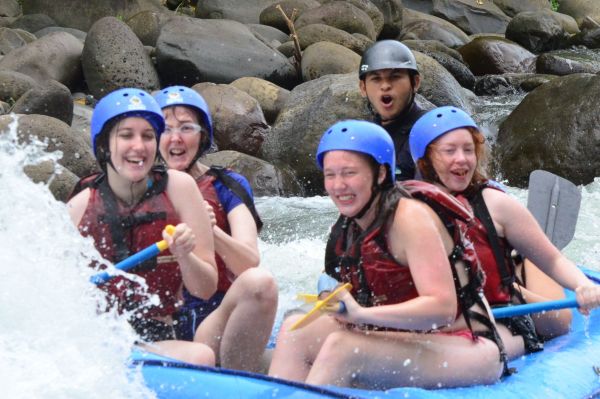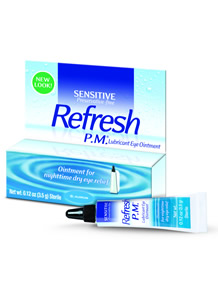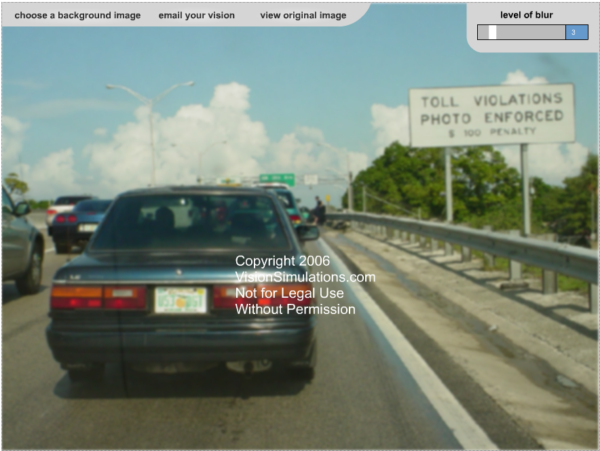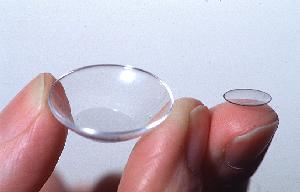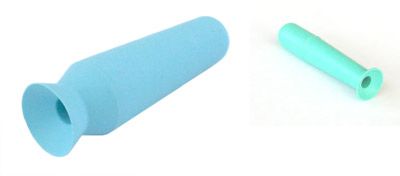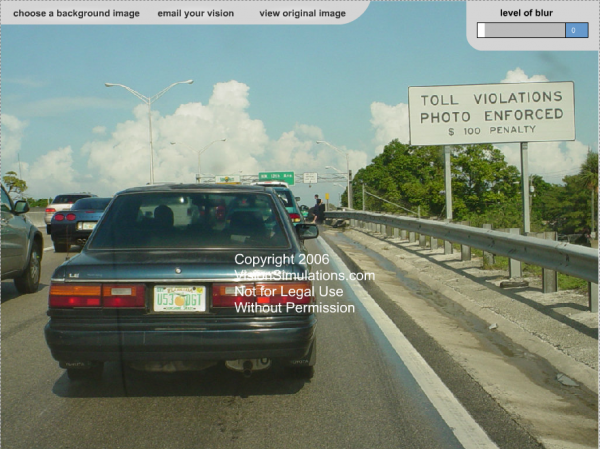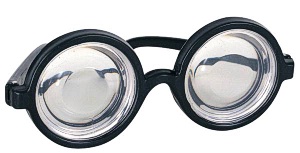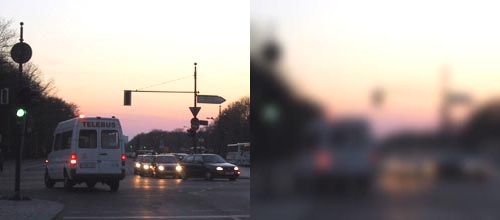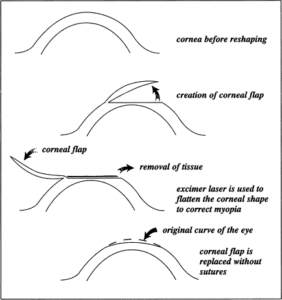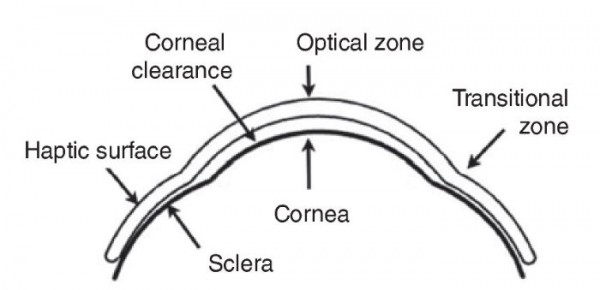This post marks the final installment of my thrilling scleral lens trilogy, following The Eyes Have it and My Dry Eye Triumph. Even as you read this, my agent is negotiating a movie deal; optimally this segment can be split into Parts 1 and 2 for a four-film series. Rumor has it many Hollywood A-list actresses are interested in playing me, that is until they find out that the role will entail extensive Botox injections on just the left half of the face to replicate facial paralysis. Filming will have to be carefully coordinated to take advantage of the right level of weakness.
Ordinarily I would toss out a disclaimer at this point, something along the lines of “But, I digress.” However, in this case, everything after the first sentence is pure and simple fiction, so instead we are interrupting this fantasy to return to your regularly scheduled programming.
Like many a good title, this one has dual meanings. My primary intent is to pass along travel-related scleral care tips and hints gathered during my trip to Costa Rica earlier this summer. More on that later.
The underlying secondary message has to do with the origin of the phrase “Have (insert gun, tux, or another term, say . . . scleral), will travel,” particularly as it relates to employment. Here’s the deal: if I could make a living as a goodwill ambassador for sclerals, I would. My wish is that everyone who suffers from facial paresis-related dry eye would find the same relief that I have. I am not exaggerating – it’s been a life changer for me. I would be happy to test any lens, try any product, make endorsements, write reviews, attend conferences, oversee a clinical trial, zipline, parasail, skydive, what-have-you. If you know of such a job, please let me know. Of course, I am willing to travel!
Which provides a lovely segue to traveling with scleral lenses (in my case just one, but for those who wear two – double the fun!).
Preparation
Once the initial thrill of returning to Costa Rica dissipated, one of my first concerns was traveling with a scleral lens. My biggest fear was losing or breaking the lens, so I contacted my optometrist about taking my initial lens (which is a step too loose) along. He agreed to do this as long as I was willing to put down a deposit on the lens. Seemed like refundable insurance to me, so I was happy to comply. (Thankfully, I never had to use the backup.)
About the same time I sent an inquiry to the manufacturer of my scleral lens about cleaning procedures for protein deposits. A few days later I got a response from Keith Parker, president of Advance Vision Technology, suggesting that we speak in person rather than try to answer multiple questions via e-mail. Once we were able to coordinate a time to talk, we had a lengthy conversation covering both the deposit issue and my upcoming travel. I am going to keep this post travel related and defer the deposit issue to a future post. (Ha! It’s going to be a four-parter after all!)
Mr. Parker assured me that suction keeps scleral lenses in place even during extreme sports. He approved of my cleaning and soaking routine and asked if I rinsed my lens in tap water between cleaning and soaking (yes, I do). He recommends rinsing in tap water in the United States – the water pressure rinses more debris from the lens – but never in a foreign country where bacteria might be an issue. Finally he informed me of a sister website, MyEyeSupply.com, for eye care supplies, including a line of solutions developed for the AVT contact lens line.
My major fear allayed, I assembled eye care products for travel:
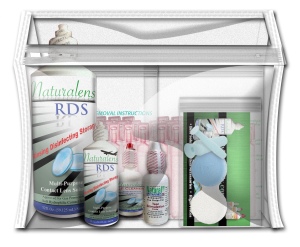 Scleral Compliance Pack – This kit contains nearly everything needed to travel with scleral lenses. Leave the 12-ounce bottle of RDS (Rinsing, Disinfection & Storage solution) at home. Take the rest – a 2-ounce bottle of RDS, a 1-ounce bottle of GP daily cleaner, wetting drops, a contact case, a lens inserter, a lens remover, and saline – along in the handy zippered bag. I chose the non-buffered kit that includes 50 5ml vials of sterile saline (Addipak). There is also a buffered option with a 3-pack of Unisol 4 instead of the Addipak vials. I prefer inserters that are hollow all the way through, so I had to snip off the end of the one from the kit, but fortunately the remover is the classic one that I like.
Scleral Compliance Pack – This kit contains nearly everything needed to travel with scleral lenses. Leave the 12-ounce bottle of RDS (Rinsing, Disinfection & Storage solution) at home. Take the rest – a 2-ounce bottle of RDS, a 1-ounce bottle of GP daily cleaner, wetting drops, a contact case, a lens inserter, a lens remover, and saline – along in the handy zippered bag. I chose the non-buffered kit that includes 50 5ml vials of sterile saline (Addipak). There is also a buffered option with a 3-pack of Unisol 4 instead of the Addipak vials. I prefer inserters that are hollow all the way through, so I had to snip off the end of the one from the kit, but fortunately the remover is the classic one that I like.
Airline regulations allow for a reasonable amount of medications in addition to the one-quart bag allowed for carry-on liquids, so I kept my contact paraphernalia separate. I printed up a couple of cards that read Medically Necessary Liquids and popped one in each side of the bag. I had no problems at any airport security checkpoint.
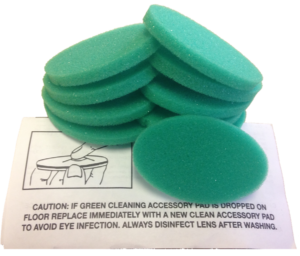 Cleaner Pads – I found this product at MyEyeSupply.com and thought it would help with the protein buildup (again, more on that in a future post) and added them to my order. Great find! These pads are designed to be used for a week and discarded. Since I wear a single lens, I cut them in half. My rule while traveling was to change every 4 days and discard if I happened to drop one (which I did). I took along two pads (four halves) for a 9-day trip, which turned out to be just right.
Cleaner Pads – I found this product at MyEyeSupply.com and thought it would help with the protein buildup (again, more on that in a future post) and added them to my order. Great find! These pads are designed to be used for a week and discarded. Since I wear a single lens, I cut them in half. My rule while traveling was to change every 4 days and discard if I happened to drop one (which I did). I took along two pads (four halves) for a 9-day trip, which turned out to be just right.
Drain Mat – This product is from my friends at the dry eye shop. It was originally an add-on item to qualify for free shipping, but it turned out to be invaluable since many of the sinks in Costa Rica did not have a stopper. Particularly that one morning when I was still so tired that I dumped the soaking solution into the sink before removing the lens.
Usual Nighttime Stuff – My favorite lubricating drops (and I have tried all that I can find) are TheraTears Liquid Gel vials. Unfortunately I can only find them locally at WalMart, but they are worth an occasional foray into the Evil Empire. At home I will recap a vial and use it for two or three applications, but when I travel I use them once and discard the rest.
I have both a pair of clear Quartz and dark Onyix eye shields from the dry eye shop, but I fashioned a custom shield using the left eyepiece from a Quartz shield and a Croakie-type glasses strap. One of these days I’ll post a tutorial because I like it much better than having both eyes covered.
Airline Travel
Scleral lenses are perfectly designed for airline travel, combating dry eye from pressurized cabin air with a fluid reservoir over the surface of the cornea, I had one tiny problem: our travel group was leaving at 1:00 in the morning to catch a red-eye international flight. My optometrist gave me strict instructions to wear the lens no more than 14-16 hours daily and soak it for a minimum of 8 hours. I could have disrupted my routine to wear the lens during the flight, but then I would have to go without the lens for a while once in Costa Rica. I opted to forgo the lens on the plane, which led to a second decision – how to keep my cornea lubricated.
The failsafe approach would have been to use Refresh PM ointment on the airplane, but that would have caused blurry vision that continued for at least the first few hours of wearing the lens. Instead, I opted to add another tool to my arsenal:
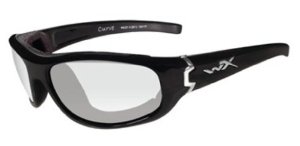 WileyX Curve With Clear Lenses – I found these glasses, actually climate-controlled motorcycle goggles, on clearance from dryeyeshop.com. They are no longer available there but plenty of other vendors carry them, including amazon.com. There are other moisture chamber options, including less expensive Dustbusters and Onion Goggles (heck, even swim goggles would work in a pinch). I found the motorcycle goggles to be a better choice because they are sturdier, seal better, and are slightly less geeky looking.
WileyX Curve With Clear Lenses – I found these glasses, actually climate-controlled motorcycle goggles, on clearance from dryeyeshop.com. They are no longer available there but plenty of other vendors carry them, including amazon.com. There are other moisture chamber options, including less expensive Dustbusters and Onion Goggles (heck, even swim goggles would work in a pinch). I found the motorcycle goggles to be a better choice because they are sturdier, seal better, and are slightly less geeky looking.
Used in conjunction with generous applications of my regular nighttime TheraTears Liquid Gel drops, the WileyX glasses is an acceptable travel protocol. The seal on the glasses is not quite tight enough so I experienced a bit of low-grade dry eye discomfort, but when that happened I just popped in more drops. Our travel itinerary from St. Louis to Liberia, Costa Rica included an hour-long layover in Miami. By that time my contact had soaked the requisite eight hours and I decided to insert it before boarding the second flight. Public restrooms are not my favorite place to deal with my lens and while I was in there I missed seeing members of the Miami Heat pass our group on their way to the NBA playoffs, but those were small prices to pay for increased comfort and clearer vision.
I had absolutely no problems on the second flight or the return flights back to St. Louis. I ended up wearing the lens slightly under 18 hours due to a bus ride that got us home just before midnight, but that turned out all right too.
Extreme Activities
The trip to Costa Rica was a 9-day environmental education tour with plenty of adventure activities mixed in. Here’s how I managed my scleral lens during the most extreme activities:
Beach – Still tired from travel, I chose to stroll on the beach and wade in the surf. Even with a spare lens and assurances that it wouldn’t pop off, I did not want to risk sea water on or under the lens.
Snorkeling – No worries. The mask provided a watertight seal, protecting the lens. I was more concerned about the waterproof case for my camera but that worked out just as well.
Rain forest hike – It rained. I wore a hat.
Ziplining – Here’s where the suction of the lens faced its biggest challenge. There was a lot of wind whistling past my face. No sunglasses allowed and just as well – they probably would have fallen off. Fourteen exhilarating zip lines and one Tarzan swing later, I was a happy camper – scleral lens intact.
Horseback ride/La Fortuna Falls hike – This is a picture of me and my horse Gugi. None of the other horses liked Gugi much, but that is a story for anther time. I wore sunglasses on the ride but never felt that I needed them for eye protection. At the waterfall I climbed out on some boulders but again opted not to submerge while wearing the lens.
Whitewater rafting – On the bus ride to Rio Sarapiquo, our whitewater guide warned us not to take phones, cameras or sunglasses as they would surely get lost during the float. During Q&A I asked about wearing a pair of swim goggles that I had brought along specifically for whitewater rafting. The guide wanted to know if they were prescription; when I said no he responded that I would be better off leaving them behind because they would fog up and diminish my enjoyment of the float. When I told him I wore a contact lens, he suggested closing my eyes if water was splashing. I gave his advice serious consideration for about ten seconds. First, wouldn’t shutting my eyes also diminish my enjoyment of the float? Second, the goggles were fog-resistant. Finally and most important, losing a $750 contact lens would flat out eliminate any enjoyment of the float.
I wore the goggles. They did not fog. I was swept off the raft and submerged. I did not lost my scleral lens. My enjoyment of the float was immense.
And there you have it. Research, preparation and common sense prevail. Have these and a scleral lens, will travel.
